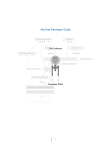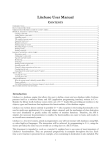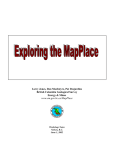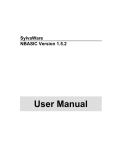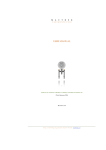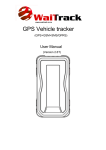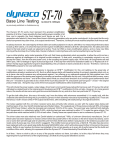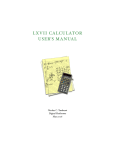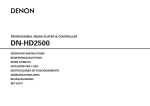Download MacTrek Developer Guide
Transcript
MacTrek Developer Guide Chris Lukassen June 2007 1 Table of contents Introduction .......................................................................................................... 3 What is Netrek? ........................................................................................................... 3 History .......................................................................................................................... 3 Basics ............................................................................................................................. 3 Document structure .................................................................................................... 4 Design Principles .................................................................................................. 5 Frameworks .................................................................................................................. 5 MVC .............................................................................................................................. 5 Factory ...........................................................................................................................5 Notifications ................................................................................................................ 6 State machine ............................................................................................................... 6 Repository .....................................................................................................................7 Design ................................................................................................................... 9 Class derivation ............................................................................................................ 9 Class grouping ............................................................................................................. 11 Coding guidelines ....................................................................................................... 14 Networking ................................................................................................................. 15 Development enviroment .................................................................................. 21 Setting up subversion source version control for Mac OS X ..................................21 Subversion and XCode ............................................................................................... 22 Checking the installation ........................................................................................... 23 Adding RSA code to your client ................................................................................ 23 Miscellaneous ..............................................................................................................25 Credits ................................................................................................................. 26 Appendix A ..........................................................................................................27 Importing Projects Into a Subversion Repository ...................................................27 Configuring your SSH environment ......................................................................... 27 Appendix B ..........................................................................................................29 Releasing a new MacTrek Version ............................................................................ 29 2 Introduction What is Netrek? Netrek is a free to play open source software cross platform multiplayer hybrid multi-directional shooter and real time strategy game for up to 16 players. The goal of the game is to capture all the opposing team’s planets. It combines “twitch” style reflexive dogfighting with extensive team play and strategy. History Netrek has a development history beginning as far back as 1972 (Alto Trek). It was also heavily influenced by the PLATO game Empire, written in 1978. It substantially reached its current form and its peak player-base in the early 1990s as a contemporary of XPilot but has dwindled steadily since then as more newbie friendly games became available. It is no longer under active development, but its client and server code still contain many design features that would be of interest to amateur or professional network games developers. Basics The graphics of Netrek are simple top-down format. You have an external view of your ship from above and the game map is laid out on a 2-D plane. Two teams face off, each controlling an equal number of planets. Planets slowly generate armies, which may be picked up by players. Enemy planets may be taken over (or retaken) by dropping enough armies on them. Armies annihilate each other on a 1 to 1 basis, so to take over a planet with 4 armies, you need to drop at least 5. A planet with 0 armies is considered to be neutral and does nothing until someone puts an army on it to claim it. Planets can be bombed to kill off armies, but cannot be bombed if the army count is 4 or less. Also, you can only pick up excess armies from your team’s planets, where “excess” is defined as over 4. Some ships have the ability to randomly bomb 2 armies at a time instead of 1, so it would be possible to bomb an army down to a population of 3 but never less than that. Before you can pick up armies, however, you need a kill. You can obtain kills either by killing an enemy ship or by bombing enemy armies. Your kill count resets back to 0 every time you die. Consequently, people with 2 or more kills are generally targeted for ogging just to remove the threat of them carrying armies around. 3 Document structure Noter: This document serves as guide how to work with the MacTrek source code. It will not describe how Netrek works, nor how the source code works, for the latter i suggest you either download the code or take a look at the doxygen description In Chapter 2 the Design principles are explained. Chapter 3 explains how to get and setup the perquisites to start working on MacTrek. Chapter 4 tells how to obtain the client code, how install and work with it. Chapter 5 tells something about the credits of this Manual and in Chapter 6 holds some appendixes which have no direct bearing on MacTrek but may be very usefull. 4 Design Principles Currently MacTrek uses a number of design patterns and different design principles. If at first glance the structure may not seem directly related to a single design pattern, the matter at hand is probably related to two or more patterns applied simultaneously. Frameworks MacTrek makes heavily use of frameworks. Most operations that can be abstracted and reused have been moved into the Luky framework branch. Currently this code is directly accessible from XCode but when this framework has reached maturity it can be moved to a separate project and managed separately. (as with the current Java version of Luky) The same is true for Libgmp which handles the RSA encryption. MVC The Model View Control pattern is at the very hart of the design. The (data) Model that represents the current state of the MacTrek data is located in classes in the folder “Data”. It consists of the MacTrek Universe class that is populated with various planets, players, teams and weapons. The View part is implemented in the NIB file. It holds most logic related to the presentation of the MacTrek Universe. Most, but not all. In the folder Gui are other classes that handle the response of View events and see to the population of the various lists, or generate a (Tactical) Map picture. The Control layer is scattered over many classes but mainly acts on the layer of the “App” classes. They intermediate between data collection and presentation. Good examples are the classes that store dynamic keymaps or handle MetaServer data. Factory Another pattern that emerges is that of the factory. The gui layer does not paint its own view but uses a PainterFactory. This factory processes the datalayer and produces a frame that represents the current data layer at a given time. There are extentions on the PainterFactory that use the same logic but paint differently. This way the Netrek Painter will draw netrek artwork and the MacTrek painter will draw MacTrek graphics. Analogue to this principle is also the SoundPlayer. 5 Threading MacTrek is multi threaded. Its communication is isolated to a single thread that updates the universe and can be locked. The drawing is done in another thread and the playing of sounds is done in dozens of threads. (at least 1 per sound) Notifications The core of MacTrek is the NotificationCenter. Since the design in threads leads to isolated bits of code there is a need for communication between the parts of the code. The communication thread may learn to know new information about the player that results in a new galactic picture, and update of the speed or hull meters in the dashboard or maybe the presentation label. MacTrek uses a notificationCenter to generate events. An event consists of a key and user data. Everywhere in the code, the programmer can subscribe to events and connect his methods to the event. Causing specific bits of code to be called when an event occurs, without knowing, where the event occurred. State machine MacTrek uses an internal state machine to know if a game can begin or not. Whether the user will login first or if a ship still needs to be selected. 6 Repository MacTrek is stored in an SVN repository with the structure based on its release numbers. The version numbers should be read as: a.b.c Where a is a major revision meaning the structure of the code changed considerable. The b indicates a minor release that has new functionality and c means bug release This is reflected in the way the repository is managed. The repository looks like this: /trunk /releases /branches (main development trunk) (holds a copy of the source at each release) (working branches of the main trunk) In the main trunk development is based on release numbers, so in time it will look like: /trunk: revision: 10 - 11 -12 -13 -14 -15 -16 -17 -18 - 19 - 20 - 21 - 22 -23 Whenever a release is made the code is freezed in the releases repository so: /releases/1.1.0 /releases/1.2.0 /releases/2.0.0 /releases/1.1.1 revision 1 (identical to /mactrek revision 16) revision 1 (identical to /mactrek revision 19) revision 1 (identical to /mactrek revision 20) revision 1 (identical to .....) Besides a release also a branch is made for each major and minor release. So to continue our example: /branches/1.1.0 revision 1 (identical to /mactrek revision 16) /branches/1.2.0 revision 1 (identical to /mactrek revision 19) /branches/2.0.0 revision 1 (identical to /mactrek revision 20) But not for bug fixes. They are related to work in a branch of a release, so: /releases/1.1.1 revision 1 (identical to /branches/1.1.0 revision 3) So in short trunk holds “latest greatest” releases are snapshots and should not be committed upon, branches are for bug fixing releases. This means that bug fixes need to be done also in the main trunk as well as in all active release branches. See also the following figure. 7 /trunk 10 11 12 13 14 15 16 17 18 19 20 /releases/1.1.0 1 /releases/1.2.0 /releases/2.0.0 /releases/1.1.1 /branches/1.1.0 /branches/1.2.0 /branches/2.0.0 1 1 1 1 2 3 1 Corresponding SVN commands Tagging the trunk for release: svn copy https://mactrek.svn.sourceforge.net/svnroot/mactrek/trunk https://mactrek.svn.sourceforge.net/svnroot/mactrek/releases/1.1.0 -m “Bug release 1.1.1 (rel 34)” Creating a branch of the trunk for release: svn copy https://mactrek.svn.sourceforge.net/svnroot/mactrek/trunk https://mactrek.svn.sourceforge.net/svnroot/mactrek/branches/1.1.0 -m “Bug release 1.1.1 (rel 34)” Tagging a branch for release: (assumes you have made changes in the branch for 1.1.0) svn copy https://mactrek.svn.sourceforge.net/svnroot/mactrek/branches/1.1.0 https://mactrek.svn.sourceforge.net/svnroot/mactrek/releases/1.1.1 -m “Bug release 1.1.1 (rel 34)” 8 1 Design Class derivation Objective – C software usually leads to very flat design. This is mostly because of the delegate pattern that is used extensively in the Gui classes. It avoids sub classing in most cases. In order to maintain the possibility to expand easily to all classes, base classes have been defined. The SimpleBaseClass has currently no logic and is a skeleton class. The BaseClass derived classed share access to the default notificationCenter and have a single access point to the universe. 9 The Classes in the universe are very well represent able using an hierarchy of classes. All elements are entities and share parameters as speed and position. Weapons and projectiles share other elements. As of MacTrek 1.1.0 A Tracker is closely related to the entity class and allows for the prediction of position based on the timestamp of the last received update. At the time of writing it is best left off since the prediction is not smoothed out and causes the the display to wobble with a sawtooth pattern. The figure above shows the universe population hierarchy 10 Class grouping Classes are also grouped by their logical function. This implies a logical reason to keep them together (in Java they would become a package) but now coding rule binds them. General Libraries. These will in the future be released under LGL on http:// luky.sourceforge.net as their current Java brethern. Package Description LLComm Communication classes e.g. NotificationCenter LLConcurrency Multi-Threading classes e.g. ThreadWorker LLCore Base classes holding common functionality for all Luky based classes LLGeo Geometrical classes, for vector and other calculations LLGui Special GUI based classes e.g. full screen background windows or transparent panels LLNetwork Complete network implementation compatible with OmniNetwork LLResources Resources required by the Luky classes LLSystem System based classes to manage processes among others. The MacTrek classes heavily depend on these libraries and are themselves organised in a similar matter. (Need to be refactored to MT classes) 11 Package Description App All control classes. These classes know nothing about the visual layer but do know how to manipulate internal data or events. Like te LoginManager or KeyMap Comm Communication based classes read and write UDP or TCP messages and translate them into events. The class Communication is the centre point and controls the separate communication thread. Data It holds the universe and more. All classes related to what happens out there. The status of the players, planets etc. Generic BaseClasses as explained before Gui The control classes that know about the visual layer. The are instantiated in the Interface builder and added to the NIB. You will find separate controllers for all menus and the centre of operations in this group is the GuiController. It contains the state diagram that makes the application switch states. Message Netrek supports RCM messaging. However, this is only partly implemented in MacTrek. There classes should convert normal messages in RCM and vice versa. Other Required classes for any Objective-C project like main.c (duh) Painter The painters do the actual drawing based on the resources they may have. The root class draws simple shapes, it’s children use images to create fancier output. It also holds the logic to switch frames in more advanced drawing like explosions. RSA All encryption based classes. Note that there are 4 classes missing from svn that hold the actual decryption key. Use res-rsa-2.9.2 from http:// sourceforge.net/projects/netrek to generate these. Sound The soundplayer family and support classes. A multithreaded entity that plays many sounds simultaneously inherit to create additional FX schemes Tracker Experimental class to see if TCP lag can be compensated with tracking. Not very successful with alpha tracking, may switch to Lagrange polynoms in the future 12 Package Views Description This is where in and output is handled. Every 1/ FRAME_RATE seconds a new view is generated and it also handles the keys that are pressed. It uses the painter to actual generate the image to be drawn to the screen. 13 Coding guidelines SCM Only code that is checked in/out using SCM is accepted as a valid change. Descriptions should be precise and every file you check in must be verified and compile-able before checking in. Syntax We follow the Apple style of coding (e.g. setVar, var (not getVar)) with one exception: Java style brackets are used. Manager/Controller Controller classes control parts of the code that have no user interaction. e.g. the LoginController handles the control logic in communication with the server. It uses the Communication class to abstract the actual traffic encapsulation. Manager classes manage part of the Gui. e.g. the LoginManager manages the interaction with the user. It tells the controller class what has happened and the controller will find the proper reply. The Gui Manager is a special manager that manages the game state based on the state diagram. It is the central spider that acts mainly on events in the system and controls for example the state of the display (menus, outfit, game etc) Theme ability MacTrek makes it easy to add new sound or graphic themes. All you need to to is override the PainterFactory or SoundPlayer classes and add your custom artwork. For sound you are required to override the loadSounds method. For graphics specific methods like drawPlayer need to be overridden. The figure above shows the class hierarchy for PainterFactory in MacTrek 1.1.x 14 Networking Working with LLNetwork You can use the LLNetwork classes to setup both TCP and UDP connections. Or even mix them. The classes contain also streaming variants of the sockets that catch more or less data in the background and which can be fetched by your software asynchronisly. Direct use of the sockets can be blocking or non-blocking. Additional care is to be taken in a threading enviroment. LLNetwork is thread safe, but accessing a blocking socket from multiple threads may lead to failure if the first thread blocks the socket, then the second thread may return with a failure code. As TCP Server: - create a LLTCPSocket - call listenOnPort to start listening for connections - call acceptConnection to wait for an incomming request (or acceptConnectionAndKeepListening) - read data or write data As TCP Client: - create a LLTCPSocket - call connectToHost to establish a connection - read data or write data As UDP Server: - create a LLUDPSocket - call listenOnPort to start listening for connections - read data (this will set the remoteHost upon reception) - write data (wil use this remote host) As UDP Client: - create a LLUDPSocket - call connectToHost to establish a connection - write data to tell the host who you are - read data Netrek UDP/TCP networking explained Extended send & receive For increased reliability, the client has extended send and receive options. In the client, commands which don’t appear to have been accepted can be repeated automatically. This is called “forced UDP”. In the server, semi-critical information can be resent automatically in a separate packet or at the end of a short packet (which increases traffic and CPU load but increases the probability that the information will get through). Another extended receive option is “fat UDP”, in which packets under 500 bytes are padded with an extra 90-100 bytes of semi-critical state info. The info will be added on a “least recently sent” basis, adjusted by how many times that particular packet has been sent since it was last modified. The extra load on the network and CPU should be minimal. When all else fails, an “update all” request is provided. Issuing this 15 request will cause all semi-critical and some non-critical data to be sent as part of the next update. This also causes fat UDP to reset itself. Critical/non-critical packets There are three levels: 0 - critical, must get through 1 - semi-critical, will confuse player if it doesn’t arrive 2 - non-critical For the server, two criteria were used: - will bad things happen if the packet doesn’t get through? - is it something which ought to be reliable and doesn’t happen very often? (ex: SP_MOTD) For the client, the semi-critical packets were chosen based on which could be detected or at least repeated without undue side-effects. For example, “det torps” is impossible to detect, and “fire torp” would often result in firing more torpedos than was desired. Some options (change speed, change direction) are simply repeated twice for good measure because there’s no harm in doing so (besides sending more packets than necessary, that is). Server critical: 1 SP_MESSAGE 2 SP_PLAYER_INFO 10 SP_WARNING 11 SP_MOTD 13 SP_QUEUE 16 SP_PICKOK 17 SP_LOGIN 19 SP_MASK 20 SP_PSTATUS 21 SP_BADVERSION 24 SP_PL_LOGIN 25 SP_RESERVED 26 SP_PLANET_LOC Server semi-critical: 3 SP_KILLS <-- not important, but semi-confusing if this is lost 5 SP_TORP_INFO 7 SP_PHASER 8 SP_PLASMA_INFO 12 SP_YOU <-- sometimes this is non-critical or critical 14 SP_STATUS 15 SP_PLANET 18 SP_FLAGS 22 SP_HOSTILE Server non-critical: 4 SP_PLAYER 6 SP_TORP 9 SP_PLASMA 16 23 SP_STATS 27 SP_SCAN (Amdahl scanning beams) 28 SP_UDP_REPLY (UDP packet; only kind sent in UDP mode is VERIFY packet) 29 SP_SEQUENCE Client critical: 1 CP_MESSAGE 8 CP_LOGIN 9 CP_OUTFIT 10 CP_WAR 22 CP_COPILOT 27 CP_SOCKET 28 CP_OPTIONS 29 CP_BYE 31 CP_UPDATES 32 CP_RESETSTATS 33 CP_RESERVED 35 CP_UDP_REQ (uses a special case to send the VERIFY packet through UDP) Client semi-critical (forced mode): 2 CP_SPEED 3 CP_DIRECTION 4 CP_PHASER 5 CP_PLASMA 12 CP_SHIELD 13 CP_REPAIR 14 CP_ORBIT 15 CP_PLANLOCK 16 CP_PLAYLOCK 17 CP_BOMB 18 CP_BEAM 19 CP_CLOAK 23 CP_REFIT 24 CP_TRACTOR 25 CP_REPRESS 30 CP_DOCKPERM Client non-critical: 6 CP_TORP 7 CP_QUIT 11 CP_PRACTR 20 CP_DET_TORPS 21 CP_DET_MYTORP 26 CP_COUP 34 CP_SCAN (Amdahl scanning beams) 36 CP_SEQUENCE (not used) 17 UDP performance and side effects It should be noted that setting the update rate to 5 frames/second does NOT mean that the server only sends five transmissions per second. It specifies a MINIMUM transmission frequency; the server will send regardless when its buffer fills. Under TCP this is about 16K, so even at 1 update/second you are unlikely to receive any information early. Under UDP the buffer size is 960 bytes, so you may receive smaller packets more often. It is quite possible to have the frame rate appear to increase when you move into the thick of a battle. This does NOT mean that the server is sending more data; it’s merely spreading the same data over several packets. It also does not mean that your display will suddenly speed up; in fact, most people used to 5 updates/second say that the display appears to slow down at 9 updates/second. The smoother display which (accidentally) results will most likely be beneficial to most people. Some quick tests showed that, even on a busy system, packets rarely exceed 700 bytes. (in case I’ve managed to hopelessly confuse you, think of it this way: the server will still be sending updates at the same rate, but some will arrive a few milliseconds earlier than the others. Your client will get some data, redraw, get more data, redraw, ... In most cases, I wouldn’t expect to receive more than two packets per update, so it shouldn’t be a major issue. That remains to be seen, however.) Socket details A typical way to connect is: - server opens a port with bind(), and passes the number to the client via TCP - client opens the UDP port, does a connect(), and sends some data via UDP - server does a recvfrom(), which supplies the client address and port - server does a connect() A two-way UDP connection is now established. Under UTS 2.1 however, recvfrom() is broken, and doesn’t always fill in the “from” parameter (the whole reason for the client sending data to ther server before the server connects is so that the server can identify the client’s host and port). Since I’m writing and debugging this under UTS, the client packet must contain the client’s UDP port number. (note that UTS product support has been made aware of the problem, and is working to fix it.) So, the connection actually works like this: - client opens a port with bind(), and passes the port number to the server - the server does a connect(), and passes it’s port number back to the client - the client does a connect() to the server’s port Explanation of UDP connection process This is somewhat involved, because there are some nasty failure states: - ntserv using UDP, client ignoring updates - client using UDP, server ignoring messages - ntserv and client both decide to use UDP, but server can’t connect - client stutters and sends a second request, causing server to reroute data ... 18 Most failures end up with server and client ignoring each other, forcing the player to disconnect. Might be worthwhile to add a “force reset” to make the server switch back to the TCP line. If this protocol does its job, then that shouldn’t be necessary. (A state diagram would be better, but harder to interpret. This is woefully incomplete, but should impart a reasonable understanding of what’s going on.) COMM_XXX indicates where the client or server expects to send/receive data STAT_XXX indicates the “state” of the client Initial state: Client: COMM_TCP, STAT_CONNECTED Server: COMM_TCP C finds a free port and bind()s it C sends a CP_UDP_REQ(COMM_UDP, client_port) Client: COMM_TCP, STAT_SWITCH_UDP Server: COMM_TCP (if the server doesn’t send a response within 25 updates, figure the server doesn’t know about UDP and reset to STAT_CONNECTED.) S checks it’s current mode: if already UDP, drop current connection and proceed below if S isn’t allowing UDP connections, it sends SP_UDP_REPLY (SWITCH_UDP_DENIED,0) S opens a UDP socket, connect()s to the client and sends a REPLY(SWITCH_UDP_OK, server_port) over TCP Client: COMM_TCP, STAT_SWITCH_UDP Server: COMM_TCP C tries to connect() to UDP port (from message) if it fails, it resets state and sends REQ(COMM_TCP,0) C sends REQ(COMM_VERIFY, 0) through UDP connection if it times out, C will reset state and send REQ(COMM_TCP,0) Client: COMM_UDP, STAT_VERIFY_UDP Server: COMM_TCP S gets the verification message and begins sending data down the UDP link First packet is a REPLY(SWITCH_VERIFY,0) (to guarantee that something does in fact get sent across the UDP connection). If the reply gets lost, and nothing else gets sent via UDP for a while, the client will time out and reset. Client: COMM_UDP, STAT_VERIFY_UDP Server: COMM_UDP C gets an update on the UDP line Client: COMM_UDP, STAT_CONNECTED 19 Server: COMM_UDP [C can now begin sending data on the UDP line] --- now switch back to TCP --C sends a REQ(COMM_TCP,0) [and stops sending data on the UDP line] Client: COMM_UDP, STAT_SWITCH_TCP Server: COMM_UDP S checks it’s current mode: if it’s already TCP, send REPLY(SWITCH_TCP_OK,0) and do nothing further S closes its UDP socket, resets its mode to COMM_TCP, and sends a REPLY(SWITCH_TCP_OK, 0) Client: COMM_UDP, STAT_SWITCH_TCP Server: COMM_TCP C closes its UDP socket, and changes mode Client: COMM_TCP, STAT_CONNECTED Server: COMM_TCP 20 Development enviroment Setting up subversion source version control for Mac OS X MacTrek’s source base is located in the subversion repository. Changes must be made on this repository in order to propagate to the client. The server is managed ad-hoc outside SCM since it is the mere generation of the official server which is under SCM at http://sourceforge.net/projects/netrek. Installing XCode First install XCode from your OS X cd or download it from the Mac OS X developersite. Installing the Subversion Software This section shows how to install the server and client software of the Subversion version control system in a computer, using DarwinPorts. DarwinPorts is an opensource project that simplifies the installation of UNIX software in several platforms, including Mac OS X. To install DarwinPorts on your computer, go to http://darwinports.opendarwin.org and follow the download instructions. After installing DarwinPorts on your computer, you should add several DarwinPorts paths to your environment. Adding these paths makes it easy to use the DarwinPorts command-line tools. If you’re using bash, you need to edit (or create) a file named .bash_profile at the root of your home directory. This is an example .bash_profile file that adds the appropriate paths to your environment: export PATH=$PATH:/opt/local/bin export MANPATH=$MANPATH:/opt/local/share/man export INFOPATH=$INFOPATH:/opt/local/share/info After modifying your .bash_profile, you must start a new shell session to pick up the changes. If you’re using Terminal, choose File > New Shell. You should ensure that you have the latest version of DarwinPorts installed. To get the latest version of the software, execute this command in Terminal: % sudo port -d selfupdate To install the Subversion software, execute this command in Terminal: > sudo port install subversion ---> Fetching apr ---> Attempting to fetch httpd-2.0.53.tar.bz2 from http://www.apache.org/dist/httpd ---> Verifying checksum(s) for apr ---> Extracting apr ... ---> Installing subversion 1.1.4_0 ---> Activating subversion 1.1.4_0 ---> Cleaning subversion Accessing the Subversion Repository 21 Subversion uses URLs (Uniform Resource Locators) to identify repositories. Using URLs, you can work with several Subversion repositories at a time. For repositories located on remote computers, Subversion offers a variety of options; one of them is SSH. To access a repository on a remote computer using SSH, use a URL such as the following: svn+ssh://<computer_name>/<repository_root>/<project_path> Before you can access a remote repository using SSH, you have to configure your SSH environment.See “Configuring Your SSH Environment” for details. Subversion and XCode Configuring Repository Access A managed project is one whose root directory is stored in a repository and whose access is controlled by a version control system. Before you can work on a managed project, you must check it out of the repository into a local copy. After you check out a project directory, you must open the project in Xcode and configure your repository-access settings. These include the name of the version control system that manages the repository, the path to the client tool, authentication information, and whether version control is active. Follow these steps to configure your repository-access settings for a project: 1. 2. 3. Open the project in Xcode. Choose your version control system from the SCM System pop-up menu in the General pane in the Project Info window Tell Xcode how to use your client tool: Click Edit and enter the path to the client program in the client configuration dialog. Note: Your client tool can be located anywhere in your file system. But you must enter the appropriate pathname in the Tool Path text field. 4. Activate version control for your copy of the project. Select Enable SCM in the General pane in the Project Info window. If you use SSH to access a Subversion repository, Xcode may ask you to enter your passphrase in the Authentication dialog, If Xcode is unable to talk to your client, a dialog describing the problem appears. 5. Commit your user file to the repository. 22 Checking Out MacTrek From a Subversion Repository To check out a project in a Subversion repository, use the svn checkout command. Its syntax is: svn checkout <repository> <target> e.g.: svn checkout https://mactrek.svn.sourceforge.net/svnroot/mactrek/trunk mactrek/ trunk to work on a bugfix in the branch 1.1.0 try. svn co https://mactrek.svn.sourceforge.net/svnroot/mactrek/branches/1.1.0 mactrek/ branches/1.1.0 Commiting your work When ready commit your work using: svn commit -m “I did good things mommy” Sensible comments are greatly appreciated. Checking the installation Press build ? Adding RSA code to your client The first time you press build it will generate some warnings in old code (probably LLSystemInformation.m) which is ok. It will also generate a warning, possibly an error on RSAWrapper.m this is not ok, but cannot be helped. By default MacTrek sourcecode is delivered without the RSA encryption files. This is to avoid reverse enginering of the key or worse :-) So you will either have to remove the RSA related files and comment out the decoding in RSAWrapper.m or add your own RSA keys to MacTrek. This paragraph describes how. Generating a key The hard way to generate a key is to get the RES-RSA package from http:// sourceforge.net/projects/netrek (MacTrek uses version 2.9.2) and in order to build it you will need GMP (MacTrek uses 4.2) The easy way is to download the mkkey utility from http://sourceforge.net/projects/mactrek Then use the following command to generate the encryption box: ./mkkey key.mactrek-1.2.0.macosx “MacTrek 1.2.0” “Mac OS X (x86/PPC Universal)” “[email protected]“ “http://sourceforge.net/projects/mactrek“ The tool will report something like: 23 mkkey version [RES-RSA 2.9.2: Mar. 13, 2000][GMP] Source basename: “rsa_box” Number of shells: 3 Number of steps between swaps: 2 Number of files: 5 Ratio of computation in files to main file: 0.8 Making new key, hold on.... Testing key .................................................. key seems OK Writing... 128 bits left, 5 files left, 21 bits in rsa_box_0.c 106 bits left, 4 files left, 4 bits in main file 101 bits left, 4 files left, 21 bits in rsa_box_1.c 79 bits left, 3 files left, 5 bits in main file 73 bits left, 3 files left, 16 bits in rsa_box_2.c 56 bits left, 2 files left, 6 bits in main file 49 bits left, 2 files left, 18 bits in rsa_box_3.c 30 bits left, 1 files left, 5 bits in main file 24 bits left, 1 files left, 17 bits in rsa_box_4.c The following files will have been added to your directory: key.mactrek-1.2.0.macosx key.mactrek-1.2.0.macosx.secret rsa_box.c rsa_box_0.c rsa_box_1.c rsa_box_2.c rsa_box_3.c rsa_box_4.c The file key.mactrek-1.2.0.macosx contains your public key and is what you should install on the server in order to get your client authenticated. The file key.mactrek-1.2.0.macosx.secret should remain secret and you will probably never need it. The other files rsa_box* contain the logic that can give a proper response to a RSA key challenge. You remember these files since the compiler already complained to you about their absense. Copy them to the right place in order to get the compiler satisfied, and your RSA decryption in place. When your code is in e.g. ~/netrek/mactrek/trunk/ copy the rsa files in ~/ netrek/RSA-SECRET/ Now press compile and done. Send your key to [email protected] to get it in the main key list. (check with: telnet clientkeys.netrek.org 3530) 24 Miscellaneous Debugging (auto)release errors It’s quite easy to release an object twice, causing MacTrek to crash somewhere else. Quite difficult to detect, therefore create the following .gdbinit file in your home folder: 1 -[NSException raise] 1 objc_exception_throw() 1 -[_NSZombie release] 1 szone_error It will trigger the debugger with some very handy breakpoints. Now add a variable to the startup enviroment in Xcode. Double click on MacTrek under executables. Set the following var: NSZombie=YES Don’t forget to remove when ready, it’s quite a memory/performance hog. 25 Credits For MacTrek and this guide: • Chris Lukassen This guide uses extensively parts from: • • • • Cocoa Dev Centre Apple XCode 2.4 user guide SVN user manual UDP explained by Andy McFadden For MacTrek too many people were involved, see the User Manual for an attempt at a complete list. 26 Appendix A Importing Projects Into a Subversion Repository To add a project directory to a Subversion repository, use the svn import command. Important: Before adding a project directory to a repository, you should move or delete the build directory if it resides in the project directory. You should also move or delete any other directories you don’t want to add to the repository. Otherwise, changes to files in those directories are tracked by your version control system and added to the repository. The svn import command syntax is: svn import -m “<import_comment>” <source> <repository> For example, to import the project directory /Developer/Examples/Networking/ Echo into a local repository, issue the following commands in Terminal: > svn import -m “Echo added to repository” /Developer/Examples/Networking/ Echo file:///svnrep/Echo Adding /Developer/Examples/Networking/Echo/EchoContext.c Adding /Developer/Examples/Networking/Echo/main.c ... Committed revision 1. Configuring your SSH environment This appendix explains how to configure SSH access from one computer (the server) to another (the client) for a single user. This allows you to connect securely from your workstation to the computer where your repository is located. The server’s administrator must create a user account for you on that computer. Make sure you can log in to the server. % ssh [email protected] [email protected]‘s password: Last login: Thu Sep 30 15:56:52 2004 from xx.xx.xx.xx Welcome to Darwin! If it doesn’t already exist, create the .ssh directory in your home directory in the server computer. % mkdir ~/.ssh % exit Using the ssh-keygen command, create a public and private key pair and store it in your home directory in the client computer: % ssh-keygen -t dsa Generating public/private dsa key pair. Enter file in which to save the key (/Volumes/Athene/ernest/.ssh/id_dsa: 27 Enter passphrase (empty for no passphrase): Enter same passphrase again: Your identification has ben saved in /Volumes/Athene/ernest/.ssh/id_dsa. Your public key has been saved in /Volumes/Athene/ernest/.ssh/id_dsa.pub. The key fingerprint is: ##:##:##:##:##:##:##:##:##:##:##:##:##:##:##:## [email protected] % cd ~/.ssh % ls id_dsa id_dsa.pub known_hosts Using the scp command, copy the public key file (id_dsa.pub) to your home directory in the server as authorized_keys (unless the authorized_keys file already exists there): % scp id_dsa.pub [email protected]:~/.ssh/authorized_keys [email protected]‘s password: id_dsa.pub 100% 613 1.2MB/s 00:00 If the authorized_keys file already exists, add your public key to it using a text editor. Make sure you can connect to the server using your passphrase: 28 Appendix B Releasing a new MacTrek Version The release of a new version consists of several steps, and because there is frequently something forgotten, a small procedure is established. 1. create a unique key for a release, patch versions can use the same key (see chapter on RSA keys) 2. distribute this key, and verify it’s reception (otherwise the release is pretty useless) 3. verify the release number in info.plist 4. update the user manual a. change log i. based on svn log -v ii. based on bugtracker at sourceforge b. describe new functionality c. update screenshots d. create a pdf e. make sure the NSZombie var for the executable is disabled (double click executables/mactrek in Xcode) 5. build the code as a release executable 6. verify the executable works a. on intel b. on ppc c. on a clean mac 7. commit the code to the trunk of svn and create release branches (see chapter on versioning) 8. update the release notes.txt if needed 9. create a suitable sized dmg (read-write) 10. set the background image 11. drag fonts, executable, user manual and release notes to the dmg 12. use disktool to create a read only copy 13. verify it works 14. upload to sourceforge: a. make sure all files are unique and have no spaces in name b. ftp -a upload.sourceforge.net c. mput diskimage, usermanual 15. login to sourceforge create a new file release from package mactrek 16. add files, changelog and release notes 17. update website of mactrek a. version number b. changes c. news d. screenshots 18. upload website to sourceforge 19. trigger the maintainer of www.netrek.org 20. update the page at www.apple.com 21. go to sleep 29





























